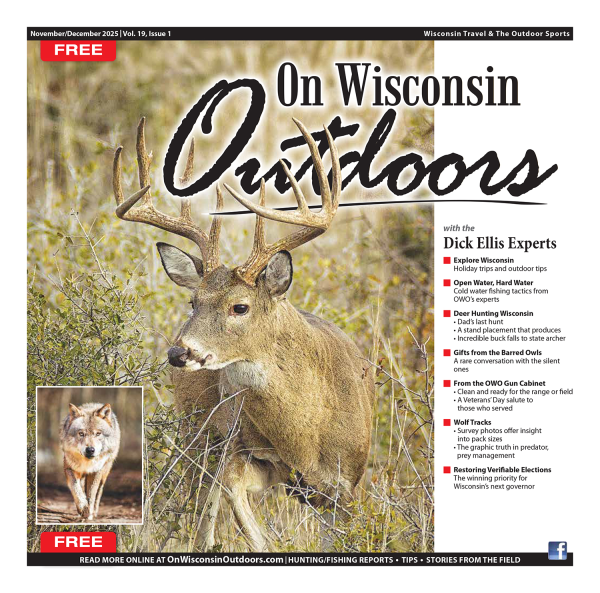OWO Wolf Management Questions/Answers Submitted to DNR
Publisher Note: As stated in the May-June issue of On Wisconsin Outdoors, the following questions were submitted to the DNR personnel leading the wolf management effort by OWO for reader review.
----------------------------------------------------------
March 12, 2021
To: Randy Johnson, Large Carnivore Specialist
Bob Nack, Big Game and Fur Bearer Section Chief
Eric Lobner, Bureau Director
From: Dick Ellis, John Ellis, Publishers, On Wisconsin Outdoors
Re: Wolf Management Planning Committee-Questions
Dear Randy, Bob and Eric,
Thank you for answering questions to follow related to the Wolf Management Planning Committee (WMPC). We submit questions in writing and appreciate your written response to ensure accuracy for our audience in future issues of On Wisconsin Outdoors (OWO). Attached also find the March-April 2021 issue of OWO, including our perspectives of the 2021 wolf hunt.
Thank you again. We look forward to working with each of you.
Dick Ellis, Publisher
John Ellis, Publisher
QUESTIONS
Who decided a new Wolf Management Planning Committee (WMPC) is needed?
DNR Bureau of Wildlife Management staff held several discussions on the topic and ultimately recommended this approach to DNR leadership which was approved.
Who is responsible for assembling and deciding who is on the new WMPC?
According to the WMPC charter, “If applications for a category outnumber the available seats, preference will be given to stakeholder organizations on the wolf advisory committee that most recently worked to update the wolf management plan. The department will then select the organizations with priority (in no particular order) given to organizations: 1) with larger memberships, 2) with broader geographic representation within the state, 3) based on an evaluation of responses on the application.”
Additional details on the application and formation process, is available on the DNR’s wolf management plan webpage here: https://dnr.wisconsin.gov/topic/wildlifehabitat/wolfmanagementplan
What is their contact information?
The wolf management plan committee chair is Randy Johnson. He can be reached at (715) 499-0010 or randy.johnson@wisconsin.gov.
Hunters and trappers advocate for the proper management of all animals, including wolves. According to the Wolf Management Plan Charter wolf advocacy groups are different. How?
The definition of hunting/trapping organization includes “support of regulated harvest as a primary tool.” While some advocacy/education organizations may support this specifically, others may not. Additionally, there is likely to be overlap in the interests and shared goals among many of the groups that identify in each of the given categories. Other examples include overlap between ag/ranching organizations that support hunting/trapping, as well as hunting/trapping organizations that support wolf education efforts.
How are businesses directly impacted economically by wolves in Wisconsin to be represented on the WMPC?
Businesses directly impacted economically by wolves should have fair representation on the committee by the appropriate stakeholder or government agency. Farmers/ranchers should be represented by the ag/ranching organizations, rural business that thrive on hunting dollars should find representation from the hunting/trapping organizations, businesses that benefit from wolf-related tourism can be represented by the advocacy/education organizations, and the U.S. Forest Service and Wisconsin County Forest Association should serve to represent the interests of public forests and associated land/forest management.
Who is the final authority for wolf management In Wisconsin (excluding on reservations where tribes manage themselves)?
The Wisconsin DNR has authority for wolf management within state borders, excluding reservation lands. This authority is preempted if wolves are listed on the federal list of endangered species where authorities then lies with the U.S. Department of the Interiors’ U.S. Fish and Wildlife Service. In addition, the Ojibwe tribes have treaty rights regarding natural resources harvest and management within the ceded territories.
The WMPC Charter states that representatives from certain government agencies, tribes, and the Wisconsin Conservation Congress (WCC) will be invited to participate. What does participate mean?
Like the other members on the Committee, they will assist in the development of an updated Wisconsin Wolf Management Plan by providing input, guidance, and recommendations to the Department during plan development. Those groups were invited to participate, as opposed to applying, based on a shared history of cooperation on wolf management. By statute, the WCC is an independent organization that serves in an advisory capacity to the natural resources board on all matters under the jurisdiction of the board and regularly participates on DNR committees.
Why are the tribes given 11 invitations to participate?
There are 11 federally recognized tribes. Each are sovereign nations and important partners in wolf management across the state of Wisconsin. All 11 tribes were invited to allow each the opportunity to participate if they so choose.
Are decisions voted on by the WMPC to be “one man, one vote?”
The committee chair (and facilitator) will strive to reach substantial effective agreement on decision items. Areas of disagreement and the basis for disagreement will be captured in the meeting notes, clearly stating the member name and organization or agency they represent. The area of disagreement and preferred recommendation from that committee member will be shared by the chair with the Wildlife Leadership Team for consideration in the Department’s decision-making process.
Is the DNR bound to follow WMPC recommendations?
No, the WMPC will operate solely as an advisory body to the department.
Will the WMPC meetings be available for viewing by the public in real time via Zoom?
Yes. Similar to all public DNR meetings, agendas and links are posted in advance on the DNR hearings and meetings calendar here: https://dnr.wisconsin.gov/calendar
If not, why not?
n/a
The population goal has never been adjusted from 350 since the 1999 wolf management plan was produced with addendum in 2006/07. Shouldn’t this be the starting point with wolf management moving forward?
The 350 number is the population level at which additional management actions such as lethal depredation control and public harvest could begin to be implemented. Unfortunately, this is frequently misunderstood and misinterpreted. Our understanding of wolf population dynamics and habitat have vastly increased since 1999 and an updated management plan provides the opportunity to share that information as well.
How did the population increase from 350 to a state estimated 1200?
Monitoring reports and population information is available here: https://dnr.wisconsin.gov/topic/WildlifeHabitat/wolf/index.html
Why wasn’t the 2021 harvest goal set to bring numbers down to 350?
The harvest goal for the February 2021 season was intended to maintain the population at its current size in order to allow further input on the future of the population by the WMPC. It would be irresponsible to attempt to reduce the population by 75% in one season. In addition, there is a 5 year post delisting monitoring period following any species that is removed from the federal list of endanger species and such a decrease would likely trigger federal review and consideration of relisting.
How was the 2021 harvest goal of 200 set?
On Feb. 11, 2021, a state circuit judge ordered the Wisconsin DNR to schedule a wolf harvest season in February. During the Natural Resources Board Special Meeting on Feb. 15, the board unanimously voted for a harvest quota of 200 wolves outside reservation lands. Given the short time remaining to implement a season, the DNR Wolf Advisory Committee was unable to meet and public input on harvest objectives was very limited. DNR biologists, research scientists, other staff and a representative from the Great Lakes Indian Fish and Wildlife Commission met to discuss relevant data and information to inform a harvest quota recommendation. Among the factors considered were the most recent wolf population estimate, the wolf population response to harvest in the 2012-14 seasons, the current management plan, the scientific literature, and estimated impacts of harvest levels on the wolf population. The final quota recommendation from the DNR was estimated to result in no annual population change while allowing a sustainable harvest of up to 200 wolves, and this recommendation was approved by the Natural Resources Board.
Was it the assumption of NRB/DNR when setting the harvest quota that the tribes would attempt to harvest the allotment they claim?
The total harvest quota is determined based on biological and scientific data. The Ojibwe tribes have legal treaty rights to declare for up to 50% of allowable harvest within the ceded territory. The DNR made no assumptions about tribal harvest intentions. Once the tribal declaration was received by DNR, permit numbers available to state hunters were calculated.
Or did 200 wolf harvest goal reflect the belief that the tribes would harvest 0 animals?
See above
With tribal harvest numbers the last 4 seasons being 0, should future harvest goals be set knowing that the tribal contribution to the harvest total will be 0?
The DNR will continue to include tribal consultation as part of the process to establish annual harvest quotas and use that consultation to inform quota recommendations.
The 2021 hunt began with allotments of 119 for state hunters and 81 for tribal members. Was the DNR harvest goal 200 or 119, regardless of tribal contribution to the harvest?
The full quota is divided between the state and tribes (119 wolves are allocated to the state, and 81 wolves are allocated to the Ojibwe Tribes in response to the Tribes’ declaration and in accordance with their treaty rights within the Ceded Territory). The DNR strived to meet the statewide quota (119) as close as possible, but it was difficult in the February season based on the number of tags that were issued under the current season structure and the reporting timelines.
Specific to that goal, would you define the final harvest of 216 wolves as acceptable or unacceptable?
Following the tribal declaration of 81 wolves in the ceded territory, the DNR harvest goal was 119 wolves in the February season. Out of honor and respect for tribal treaty rights, harvesting 216 wolves was undesirable. Biologically speaking, the harvest goal of 200 wolves was intended to maintain the population at current levels. In that case, harvesting over the harvest goal is undesirable as well, but there is variation in the expected outcome of this harvest and the additional harvest is not expected to have significant long-term population impacts.
Why?
See above.
How are wolf packs and total population counted/estimated?
The annual wolf monitoring reports (which detail methodology) are available here: https://dnr.wisconsin.gov/topic/WildlifeHabitat/wolf/index.html
Are these methods accurate?
There is uncertainty inherent in all wildlife population models. The model used by the DNR to estimate the wolf population is well-supported by scientific research and experience. Similar models are used to monitor wolves in Montana as well as a variety of species around the world.
What is the square miles territory of the ceded territory?
22,400 sq. miles. https://dnr.wisconsin.gov/topic/Fishing/ceded
Hunters harvested 216 wolves or more than 18 percent of 1200 if that total population estimate is correct. Doesn’t the total kill, over the square miles of ceded areas and territory south, point to the state population estimate being incorrect, and significantly lower than real number?
Regarding population size, we’ve heard concerns about impacts of taking a certain percentage of the population and we’ve also heard concerns about the DNR population estimate being inaccurate based upon the rate of harvest. However, the current estimate of approximately 1,200 wolves is from April 2020 and comes on the heels of a 13% increase from the previous year. We do not have a 2021 estimate yet, but it is entirely possible the population increased, decreased, or did not change from 1,200.
The increased rate of harvest observed during the February 2021 season as compared to previous wolf seasons is the result of many factors. First, the Natural Resources Board approved twice as many permits per quota for this season as compared to previous seasons. Second, the use of dogs to track wolves, which is an efficient method of harvest, was available for the full season as opposed to previous seasons where use of dogs wasn’t open until later in the season and in some cases, zones were already closed. Third, fresh snow across much of the state resulted in excellent tracking conditions likely leading to higher success rates among most methods of take. Finally, the wolf population is larger than it was during previous seasons, and the quota for this season was on the low end compared to previous years, which should translate to increased opportunities and potentially shorter closure times.
Is it the tribes’ written right by treaty to claim but not harvest their wolf allotment?
The Ojibwe tribes have legal treaty rights to declare for up to 50% of allowable harvest within the ceded territory.
What is the primary food source of the wolf in Wisconsin?
White-tailed deer.
How many deer on average will an adult wolf consume in one year?
Research in Minnesota estimated on average each wolf consumes 15-20 adult sized deer per year or their equivalent.
What would have been the estimated recruitment number of new pups this year if a hunt had not been held and assuming the population is 1200?
The estimate of 1,200 wolves (in approximately 256 packs) is from April 2020. Assuming an average litter of 5 pups apiece, the population would be expected to double immediately following in spring 2020. The spring population will decline throughout the year influenced by prey availability and the multitude of mortality sources and reach its low point again the following winter.








